Mauritius kestrel
The Mauritius kestrel (Falco punctatus) is a bird of prey from the family Falconidae endemic to the forests of Mauritius, where it is restricted to the southwestern plateau's forests, cliffs, and ravines.[3] It is the most distinct of the Indian Ocean kestrels. It colonized its island home to evolve into a distinct species probably during the Gelasian (Late Pliocene[4]). It is the most distant living species among the western Indian Ocean kestrels (Groombridge et al. 2002, qv Réunion kestrel).
| Mauritius kestrel | |
|---|---|
.jpg.webp) | |
| Ebony Forest, Mauritius | |
| Scientific classification | |
| Domain: | Eukaryota |
| Kingdom: | Animalia |
| Phylum: | Chordata |
| Clade: | Dinosauria |
| Class: | Aves |
| Order: | Falconiformes |
| Family: | Falconidae |
| Genus: | Falco |
| Species: | F. punctatus |
| Binomial name | |
| Falco punctatus Temminck, 1821 | |
_2.jpg.webp)
By 1974 the Mauritius kestrel was close to extinction, with only four known birds including one breeding female. After a number of conservation efforts, by 2019 there was a population of about 400 birds. This conservation achievement is regarded as one of the most successful and best documented bird restoration projects in the world.[5] It was proclaimed the national bird of Mauritius in March 2022 to mark the 30th anniversary of the Republic of Mauritius.[6]
Description
It can reach a size between 26 and 30.5 cm (10.2 and 12.0 in). It weighs up to 250 g (8.8 oz). Males are slightly smaller than the females. Wingspan is approximately 45 cm (18 in) and the wings are rounded, unlike those of other falcons.[3] The lifespan is 15 years in captivity.
Behavior
The Mauritius kestrel hunts by means of short, swift flights through forests.[3] It is carnivorous, eating geckos, dragonflies, cicadas, cockroaches, crickets, and small birds.[3]
Conservation
In pre-colonial time the population was estimated between 175 and 325 breeding pairs. This small population was caused most likely by deforestation in the 18th century and by cyclones. But the most severe decline was in the 1950s and 1960s due to indiscriminate DDT use and invasive species like cats, mongooses and crab-eating macaques which killed the kestrels and their eggs. What was probably this species' closest relative in Recent times, the Réunion kestrel, became extinct around 1700.
The recorded population dropped to an all-time low of only 4 individuals in 1974 and it was considered the rarest bird in the world. Stanley Temple from Cornell University studied this species for two years and the first attempt in 1973 to breed the birds in captivity failed because the hatchling died when the incubator had a breakdown. Though conservation measures were immediately undertaken with the help of a breeding program by the Jersey Zoo (now Durrell Wildlife Park), the efforts to rescue this species initially failed because the eggs were not fertile.
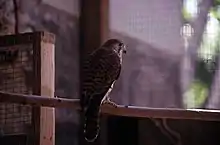
In 1979 a new attempt was undertaken. With the help of Gerald Durrell, the Welsh biologist Carl Jones established a wildlife sanctuary on Ile aux Aigrettes. He climbed on the trees and removed the eggs from the nests. This time the eggs were fertile, and Jones was able to rear the hatchlings in incubators. The wild kestrels' diet was supplemented so they would be able to lay a new egg after the first one was removed, averting any negative impact on the wild population. Slowly the population increased and during a census in 1984 50 individuals were estimated. Techniques for breeding, release, and "hacking" of young birds were improved, the captive breeding center becoming a pioneering research institution for tropical raptor and small falcon conservation. The captive breeding programme was scaled back in the early 1990s as a self-sustaining population was established. Since 1994, the programme serves only as a safeguard, should some catastrophe befall the wild population, and other rare endemics are now being cared for at the station (such as the pink pigeon or the Mauritius fody).
In 2005, there were at least 800 mature birds; it is estimated that the remaining habitat allows for a carrying capacity of maybe 50-150 more (BirdLife International 2006a,b). They occur in the remaining forests of the island, especially in the Black River Gorges region. The species was downlisted to vulnerable by the IUCN in 1994 as releases of captive-bred birds became unnecessary. Little conservation action was deemed necessary only two decades - in Mauritius kestrel terms, a long lifetime or maybe 4-5 generations - after the species had stood at the very brink of extinction. Today, apart from routine monitoring to be able to assist individual couples that fail to establish breeding territories for lack of nesting facilities - a major limiting factor, the ongoing control of introduced predators is basically all that is being done to assist the species' survival (BirdLife International 2006a,b).
In 2014, the species was uplisted to endangered due to a decline in a once increasing population. It is believed that there are less than 400 mature birds alive in the wild.
While some apparent inbreeding depression was noted in the captive birds, it was certainly lower than might be expected given that the effective population size was maybe 5 individuals during the mid-1970s. It is known that several genetic lineages of Mauritius kestrels have disappeared entirely during the 20th century population decline. However, the debilitating effects of DDT accumulation on the birds' health, and not inbreeding, are considered to have been the major cause for the failure of Temple's breeding program.
The evolutionary history of the birds seems to hold clues as to why (Groombridge et al. 2002): Mauritius is a volcanic island, and although the colonization of the island by kestrels cannot be dated with high precision, it was almost certainly some time before volcanic activity died down. The Mauritius kestrel population seems to have survived a prolonged period of volcanic activity, which must have kept the population small and fluctuating as habitat, food, and kestrels were destroyed by volcanic eruptions time and again. As near-panmictic conditions were sustained for many generations, alleles that might cause inbreeding depression were steadily removed by means of natural selection. The phenomenon that effective population sizes as low as 4-5 can be tolerated without pronounced inbreeding depression is also known from other small-island birds, such as Petroica traversi or the Laysan duck.
The classification as an endangered species is due to the same fact: on an island as small as Mauritius, chance events like volcanic eruptions (hardly likely in our time) or storms (common and possibly increasing in frequency and strength) can always wipe out major parts of a species' population (BirdLife International 2006a,b).
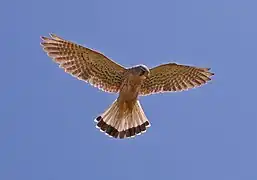 Mauritius Kestrel in Kestrel Valley Mauritius
Mauritius Kestrel in Kestrel Valley Mauritius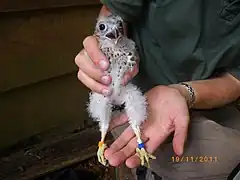 Mauritius Kestrel born in Kestrel Valley Mauritius, 2011
Mauritius Kestrel born in Kestrel Valley Mauritius, 2011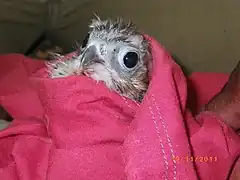 Mauritius Kestrel born in Kestrel Valley Mauritius, 2011
Mauritius Kestrel born in Kestrel Valley Mauritius, 2011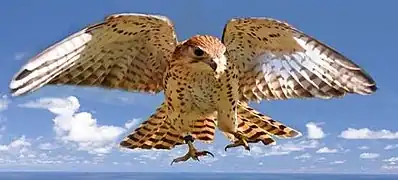 Mauritius Kestrel in Kestrel Valley Mauritius
Mauritius Kestrel in Kestrel Valley Mauritius
References
- BirdLife International (2006b): Mauritius Kestrel - BirdLife Species Factsheet. Retrieved 2007-MAR-1.
- Diamond, Anthony W.& Roger Tory Peterson Institute (RTPI) (1989): Save the Birds. Houghton Mifflin, Boston. ISBN 0-395-51172-0
- Erritzoe, Johannes & Erritzoe, Helga (1993): The Birds of CITES and How to Identify Them. Lutterworth Press. ISBN 0-7188-2895-X
- Ferguson-Lees, James & Christie, David A. (2001): Raptors of the World. Houghton Mifflin, Boston. ISBN 0-618-12762-3
- Groombridge, Jim J.; Jones, Carl G.; Bayes, Michelle K.; van Zyl, Anthony J.; Carrillo, José; Nichols, Richard A. & Bruford, Michael W. (2002): A molecular phylogeny of African kestrels with reference to divergence across the Indian Ocean. Molecular Phylogenetics and Evolution 25(2): 267–277. doi:10.1016/S1055-7903(02)00254-3 (HTML abstract)
- Staub, France (1976): Birds of the Mascarenes and Saint Brandon
Footnotes
- BirdLife International (2016). "Falco punctatus". IUCN Red List of Threatened Species. 2016: e.T22696373A93557909. doi:10.2305/IUCN.UK.2016-3.RLTS.T22696373A93557909.en. Retrieved 12 November 2021.
- "Appendices | CITES". cites.org. Retrieved 2022-01-14.
- Ellis, Richard (2004). No Turning Back: The Life and Death of Animal Species. New York: Harper Perennial. p. 279. ISBN 0-06-055804-0.
- Possibly to be moved to the Early Pleistocene. See Groombridge et al. (2002) for a thorough discussion of this species' recent evolutionary history.
- "The Mauritius Kestrel: A Conservation Success Story | Wildlife Preservation Canada Blog".
- "The Mauritius Kestrel officially proclaimed National Bird of the Republic".
